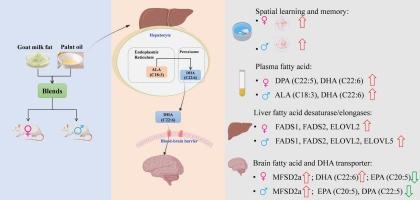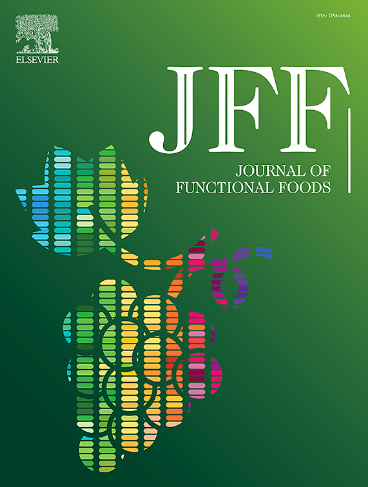Goat milk fat blends promote conversion of ALA to DHA in rats
IF 4
2区 农林科学
Q2 FOOD SCIENCE & TECHNOLOGY
引用次数: 0
Abstract
This study investigated the effects and mechanisms of different fats on the conversion of “Alpha-linolenic acid (C18:3n-3, ALA) to docosahexaenoic acid (C22:6n-3, DHA)” in female and male SD rats. The results showed that compared with the control group, the number of platform crossings in the water maze experiment in the goat milk fat group significantly increased, and the contents of DHA and the expression of ALA-DHA converting enzyme in plasma and brain tissue both increased. We believe that goat milk fat promotes the conversion of ALA to DHA in the body and increases the content of DHA in plasma by increasing the expression of key enzymes in the ALA-DHA conversion pathway. The mixture of goat milk fat and ALA can increase the expression of the DHA transporter MFSD2a, thereby increasing the DHA content in the cerebral cortex and ultimately enhancing the learning and memory ability of rats.

羊乳脂肪混合物促进大鼠ALA转化为DHA
本研究探讨了不同脂肪对雌性和雄性SD大鼠α -亚麻酸(C18:3n-3, ALA)转化为二十二碳六烯酸(C22:6n-3, DHA)的影响及其机制。结果表明,与对照组相比,羊乳脂肪组水迷宫实验中平台穿越次数显著增加,血浆和脑组织中DHA含量及ALA-DHA转化酶表达均升高。我们认为,羊奶脂肪通过增加ALA-DHA转化途径中关键酶的表达,促进了体内ALA向DHA的转化,增加了血浆中DHA的含量。羊奶脂肪和ALA的混合物可以增加DHA转运体MFSD2a的表达,从而增加大脑皮层DHA的含量,最终增强大鼠的学习记忆能力。
本文章由计算机程序翻译,如有差异,请以英文原文为准。
求助全文
约1分钟内获得全文
求助全文
来源期刊

Journal of Functional Foods
FOOD SCIENCE & TECHNOLOGY-
CiteScore
9.60
自引率
1.80%
发文量
428
审稿时长
76 days
期刊介绍:
Journal of Functional Foods continues with the same aims and scope, editorial team, submission system and rigorous peer review. We give authors the possibility to publish their top-quality papers in a well-established leading journal in the food and nutrition fields. The Journal will keep its rigorous criteria to screen high impact research addressing relevant scientific topics and performed by sound methodologies.
The Journal of Functional Foods aims to bring together the results of fundamental and applied research into healthy foods and biologically active food ingredients.
The Journal is centered in the specific area at the boundaries among food technology, nutrition and health welcoming papers having a good interdisciplinary approach. The Journal will cover the fields of plant bioactives; dietary fibre, probiotics; functional lipids; bioactive peptides; vitamins, minerals and botanicals and other dietary supplements. Nutritional and technological aspects related to the development of functional foods and beverages are of core interest to the journal. Experimental works dealing with food digestion, bioavailability of food bioactives and on the mechanisms by which foods and their components are able to modulate physiological parameters connected with disease prevention are of particular interest as well as those dealing with personalized nutrition and nutritional needs in pathological subjects.
 求助内容:
求助内容: 应助结果提醒方式:
应助结果提醒方式:


